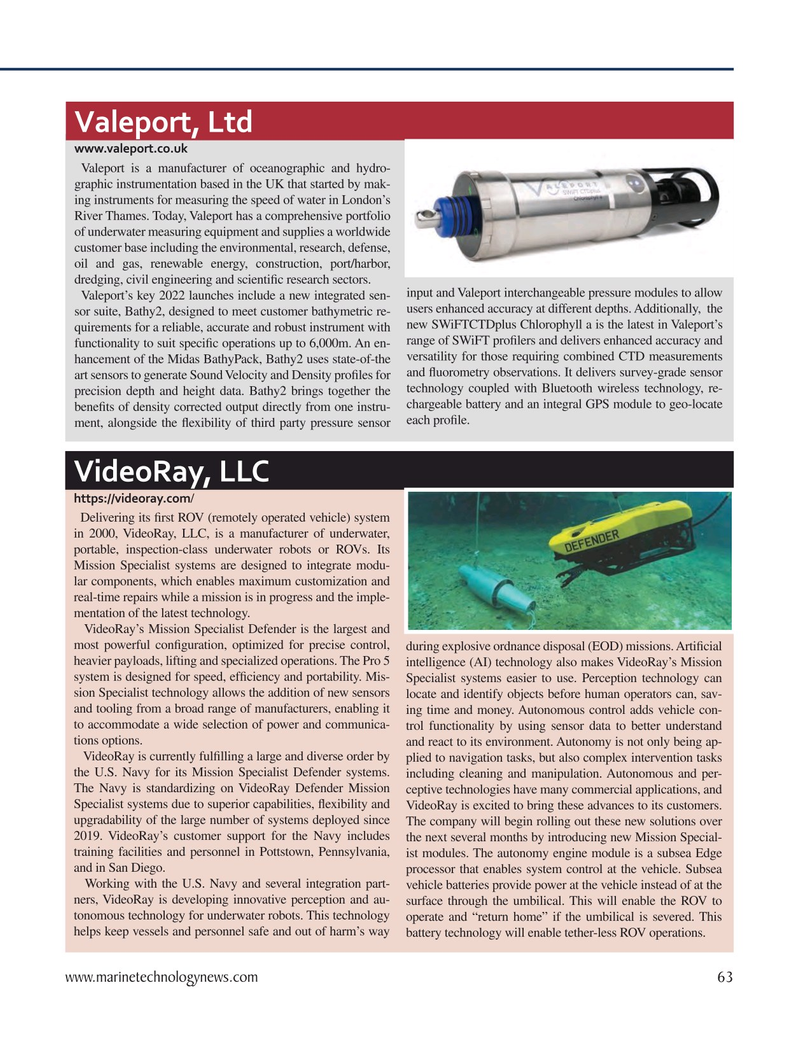
Page 63: of Marine Technology Magazine (September 2022)
Read this page in Pdf, Flash or Html5 edition of September 2022 Marine Technology Magazine
Valeport, Ltd www.valeport.co.uk
Valeport is a manufacturer of oceanographic and hydro- graphic instrumentation based in the UK that started by mak- ing instruments for measuring the speed of water in London’s
River Thames. Today, Valeport has a comprehensive portfolio of underwater measuring equipment and supplies a worldwide customer base including the environmental, research, defense, oil and gas, renewable energy, construction, port/harbor, dredging, civil engineering and scienti? c research sectors. input and Valeport interchangeable pressure modules to allow
Valeport’s key 2022 launches include a new integrated sen- users enhanced accuracy at different depths. Additionally, the sor suite, Bathy2, designed to meet customer bathymetric re- quirements for a reliable, accurate and robust instrument with new SWiFTCTDplus Chlorophyll a is the latest in Valeport’s range of SWiFT pro? lers and delivers enhanced accuracy and functionality to suit speci? c operations up to 6,000m. An en- hancement of the Midas BathyPack, Bathy2 uses state-of-the versatility for those requiring combined CTD measurements and ? uorometry observations. It delivers survey-grade sensor art sensors to generate Sound Velocity and Density pro? les for precision depth and height data. Bathy2 brings together the technology coupled with Bluetooth wireless technology, re- chargeable battery and an integral GPS module to geo-locate bene? ts of density corrected output directly from one instru- ment, alongside the ? exibility of third party pressure sensor each pro? le.
VideoRay, LLC https://videoray.com/
Delivering its ? rst ROV (remotely operated vehicle) system in 2000, VideoRay, LLC, is a manufacturer of underwater, portable, inspection-class underwater robots or ROVs. Its
Mission Specialist systems are designed to integrate modu- lar components, which enables maximum customization and real-time repairs while a mission is in progress and the imple- mentation of the latest technology.
VideoRay’s Mission Specialist Defender is the largest and most powerful con? guration, optimized for precise control, during explosive ordnance disposal (EOD) missions. Arti? cial heavier payloads, lifting and specialized operations. The Pro 5 intelligence (AI) technology also makes VideoRay’s Mission system is designed for speed, ef? ciency and portability. Mis-
Specialist systems easier to use. Perception technology can sion Specialist technology allows the addition of new sensors locate and identify objects before human operators can, sav- and tooling from a broad range of manufacturers, enabling it ing time and money. Autonomous control adds vehicle con- to accommodate a wide selection of power and communica- trol functionality by using sensor data to better understand tions options.
and react to its environment. Autonomy is not only being ap- VideoRay is currently ful? lling a large and diverse order by plied to navigation tasks, but also complex intervention tasks the U.S. Navy for its Mission Specialist Defender systems. including cleaning and manipulation. Autonomous and per-
The Navy is standardizing on VideoRay Defender Mission ceptive technologies have many commercial applications, and
Specialist systems due to superior capabilities, ? exibility and VideoRay is excited to bring these advances to its customers. upgradability of the large number of systems deployed since The company will begin rolling out these new solutions over 2019. VideoRay’s customer support for the Navy includes the next several months by introducing new Mission Special- training facilities and personnel in Pottstown, Pennsylvania, ist modules. The autonomy engine module is a subsea Edge and in San Diego.
processor that enables system control at the vehicle. Subsea Working with the U.S. Navy and several integration part- vehicle batteries provide power at the vehicle instead of at the ners, VideoRay is developing innovative perception and au- surface through the umbilical. This will enable the ROV to tonomous technology for underwater robots. This technology operate and “return home” if the umbilical is severed. This helps keep vessels and personnel safe and out of harm’s way battery technology will enable tether-less ROV operations.
www.marinetechnologynews.com 63
MTR #7 (50-65).indd 63 10/3/2022 4:35:00 PM

 62
62

 64
64
